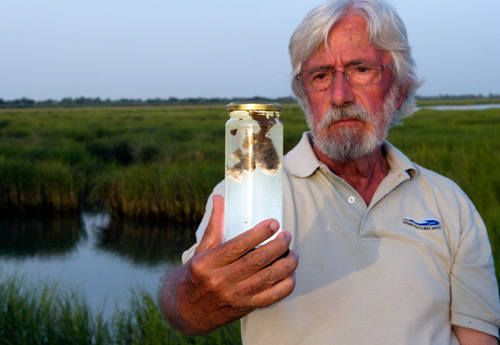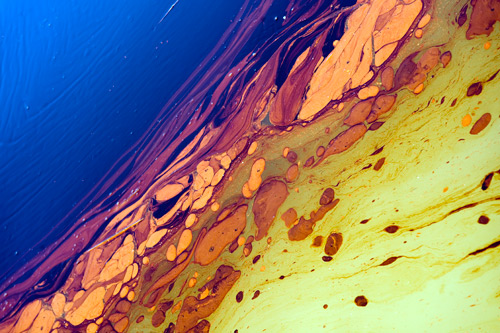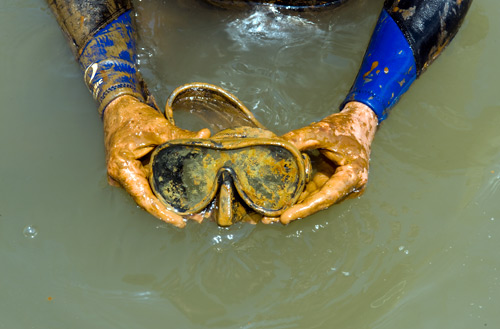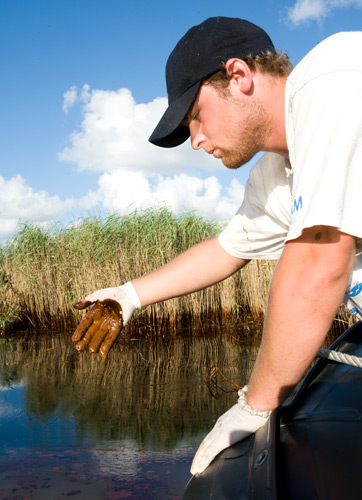Gulf of Mexico Oil Spill: What Have We Learned?
By Jean-Michel Cousteau

It will take years, maybe even decades, before we know the full impact of the Deepwater Horizon oil spill, but we will begin to get a sense of just how far-reaching its effects are as the first round of wintering migratory birds makes their way through the Gulf Coast this fall and winter. Coming from as far away as the Arctic, Canada and Greenland, one billion birds, comprising hundreds of species, will pass through the Gulf of Mexico this year, seeking a place to rest and find nourishment before continuing their flight to warmer winter habitats, many in the Southern Hemisphere.
My team and I were on location in the Gulf of Mexico just weeks after the fatal explosion of the Deepwater Horizon on April 20. We were some of the first divers to film under water and our footage became evidence that masses of oil were moving beneath the surface and couldn’t be ignored. That was just one aspect of what has become an unprecedented event—never before have we had to deal with such large volumes of oil throughout the water column, to such depths. Never before have we had to deal with the effects of dispersants in such large volumes.
In the nine weeks my team spent in the Gulf of Mexico on two separate expeditions, we were fortunate to get to know the people and places of these events—the fishermen, pelicans, dolphins, crabs, turtles, shop owners, tourists, rig operators, the blackened marshes and beaches. But every day we asked ourselves, what is the bigger picture? Where is there hope and how soon?

Big Picture
At the scale of ocean currents and the dynamic processes that drive our planet, we know that the Gulf of Mexico is bathed in the southern waters and life of the Meso-American Barrier Reef System, the second longest barrier reef in the world and a center of diversity, historically radiating vitality to the Gulf, seeding it with legendary abundance. This is what we hope for the future.
For now, the story of the Gulf oil spill is still an exploration into unknown territory and unknown science as well. As my father and I have often stated, if we knew exactly what we would find, we wouldn’t have to go. This mission requires that attitude of exploration to go and see for ourselves and, as always, to share not only what we find, but to add our perspective and experience. Sadly, it seems that it takes a disaster of this magnitude to create the motivation for change, from an individual level up to corporate and political levels. We are all involved in this horrific, preventable disaster unfolding in the Gulf. We all must work together to ensure this type of environmental horror does not happen again – not only for us but also for all species with which we share this water planet.
Migratory birds are just one of many species that are our canaries in the coalmine; populations that may ride out the wave of this catastrophe or that may crash and take decades to recover. This season, all we can do is get out our binoculars and appreciate an ancient migration that has depended on the Gulf of Mexico as a critical habitat, one of the most important migratory bird corridors on Earth, sustaining millions of birds for thousands of years. The skies might not be blackened by billions of birds as they were less than a hundred years ago, but these migratory birds are still an important link, connecting land to sea. They bridge vast habitats, reminding us that we live on a liquid planet, a home that we can’t take for granted and where we have to value all life as a gift to cherish and protect.
Everything is connected and this event connects and touches us all.

Not only does the ocean cover 70 percent of the planet’s surface, it also touches us in ways we forget. The ocean drives climate and weather patterns, generates more than 70 percent of the oxygen we breathe, absorbs carbon dioxide, feeds clouds with rain-inducing moisture, provides food, connects cultures, inspires our spirits and, most importantly, sustains all life on this planet.
Yet the vitality and diversity of the ocean is being compromised largely by one terrestrial species…US. It is unfortunate that it takes catastrophes such as the Gulf of Mexico oil spill for us to remember our direct connection to the vulnerability of our life support system. And now that we have passed the six-month anniversary of the Deep Horizon explosion, what have we learned?
The Gulf of Mexico is the ninth largest body of water on the planet, supporting a wide range of species from microscopic plankton to the largest whales in the world. It is home to the highest diversity of life found in any ecosystem on this planet, the coral reef. Spawning under the darkness of night, only a handful of nights out of the year, corals release their future generation in to the water column to be swept away by complex currents and to form new reefs in far off places, connecting the Gulf of Mexico to the rest of the water planet.
The Gulf of Mexico is also home to a wide range of habitats that support complex webs of life, from marshlands to mangroves, from open-ocean to deep-sea benthic communities. Within these habitats are the iconic species of the Gulf: five species of sea turtles, aggregating schools of Goliath Groupers, endangered blue fin tunas, societies of bottlenose dolphins, and billions of resident and migratory birds.
What we do know is that before the tragic day on April 20, the Gulf of Mexico was already a highly stressed ecosystem. The Mississippi River not only delivers valuable sediment that helps to nourish the Mississippi delta, it also transports a toxic river of fertilizers, chemicals and pollutants into the Gulf that are creating one of the largest dead zones in the world, now the size of New Jersey and getting bigger every year.
This region has been an on-going experiment on how humans try to control nature, from natural flooding events and hurricanes. We have altered, manipulated and controlled the flow of the Mississippi for over 80 years. And now we are coming to terms with what this means to the natural flow and replenishment of the barrier islands that support a rich ecosystem and connect the Mississippi River with the entire Gulf of Mexico. We are literally destroying one of the richest breadbaskets of America.
These areas used to be dynamic, naturally ebbing and flowing under nature’s rhythms. They have supported a diverse range of wildlife that has adapted to this ever-changing aquatic way of life. Ninety percent of all marine species in the Gulf depend on coastal estuaries at some point in their lifetimes. But now we have stopped, blocked, or channeled this natural flow of water with flood control projects that are today stripping the delta and marshlands of valuable resources that keep them alive. Over 50 percent of the Gulf region’s wetlands have been lost since the 1970s.
Despite these human induced stresses, the Gulf of Mexico is still an extremely rich fishing ground, producing 50 percent of U.S. shrimp, 35 percent of the nation’s blue claw crabs, and 40 percent of its oysters. But increasingly, fishing practices have put tremendous pressure on these vulnerable natural resources, pushing some fisheries towards collapse.
The area is also rich in petroleum resources and has been for tens of thousands of years. Today the Gulf of Mexico supports over 4,000 offshore oil and gas platforms and tens of thousands of miles of pipelines. Ninety percent of our country’s offshore drilling takes place here; but as we all now clearly understand, it comes with a heavy price.

Deepwater Horizon exploded on April 20 and was finally capped 86 days later. It took weeks to determine the total of amount of oil leaked; experts now say 4.9 million barrels spilled into the Gulf from five miles under the surface of the sea, making this the largest marine spill in history. 1.8 million gallons of toxic dispersants were also added, making this the largest toxic experiment ever conducted in a body of water.
I was on location in the Gulf with my team to help document this disaster, seeking answers and telling the stories of the local communities that must endure this catastrophe for years to come. We traveled to Louisiana by van and planes, carbon off-setting our entire expedition – doing what one team can do, knowing we are not going to wean ourselves from fossil fuel anytime soon, but hoping to inspire those following us that every action counts.
We spent days on the water. We were not only some of the first divers under the surface, documenting the dispersed oil throughout the entire water column, but we also came face to face with the animals and their marshland homes destroyed by oil mixed with toxic dispersants.
On many mornings, we departed from harbours all around the Louisiana coast at the crack of dawn alongside shrimp boats hired by British Petroleum to help contain and clean up the oil spill. But what we painstakingly witnessed from water level was how ineffective many of these attempts were. We found booms encircling critical nesting habitats for sea birds. These birds flew over the booms to feed at sea and consequently brought the oil back to their nests, back to their hungry chicks.
From the air, we saw miles and miles of surface oil, areas of convergence current zones where the oil would concentrate. We could only imagine all the animals that not only depend on currents for transportation, but also all those animals that feed along these convergent current lines that are now ingesting oil.
As the national media portrayed the heart-wrenching images of animals being directly impacted by the oil spill, we spent days with individual people doing everything they could to save them. We filmed the dedication and hard work of the Audubon Nature Institute and Michele Kelley, who is in charge of the team that cleans and cares for sea turtles that come into their facility just south of New Orleans. When we visited in mid July, they had 123 sea turtles of four different species, and they were busy building more tanks to house more victims of this hideous disaster. To date, 588 sea turtles have been rescued and cleaned and are awaiting their release when the biologists feel it safe for them to go home.
We spent time with the veterinarians and caretakers from the International Bird Rescue Research Center who worked around the clock ensuring a high survival rate of 35 different species of shore birds and sea birds that came into their Fort Jackson facility. We watched the birds being meticulously cleaned, one feather at a time, in what must be a fairly stressful cleaning process for them.
These devoted caretakers knew cleaning and saving these birds was only a band-aid for the much larger insult taking place in the Gulf of Mexico. A billion migratory birds are still due to arrive in the Gulf region over the next few months during the fall and winter migration, connecting entire continents to the Gulf region.
With the realization that the impacts of this one spill will be felt for decades to come, my team enjoyed a memorable moment of filming the release of 32 laughing gulls. As we helped open the door to their cages, we felt we too were doing what we could to give back to an ecosystem that has given us so much!
With global attention focused on the Gulf and its economic and conservation importance, it is our hope that this disaster serves as a wake-up call and as a catalyst for bringing more focus and funding to these waters, which are the lifeblood of both the Gulf’s many communities and its rich biological diversity. With my exploration of this region, my goals are to motivate us all to move from disaster to hope, from oil and oil spill to sun and wind and new technologies and new jobs.
At OFS we understand what humans are capable of when faced with a crisis, but what we are trying to instill in future generations is not to deal only with crisis management but instead to prevent crises altogether. We must learn how to be better Ambassadors of the Environment, using our hearts as much as our heads in making the best environmental choices and inspiring us all to move towards a more sustainable future! It is what we owe to ourselves and to all those who are yet to follow in our footsteps.

Be The Solution!
As consumers, we depend on the use of oil. Now is the time to take a look at alternatives. For whatever you can afford, there are ways to work toward using renewable energies:
Experiment with your own lifestyle. Take a day, a week, or a month to use limited or no fossil fuels. Instead, focus only on renewable energy sources. Try walking, biking more, burning candles, using solar power. See what it’s like. Know that for one day, you have helped the environment by consuming less.
Carbon Offsetting supports the development of renewable energy while empowering people to shrink their carbon footprint. Take a moment and calculate your own carbon footprint at www.b-e-f.org/carbon/calc/
Do you regularly ship packages? Consider minimizing the carbon footprint for your online purchases and shipments at www.greenshipping.com.
Some studies estimate the Internet will be producing 20 percent of the world’s greenhouse gases by 2020. If you have a website, look into solar powered hosting services at www.aiso.net
Did you know that the heavier your car, the less fuel-efficient it becomes? An extra 50 pounds (23kg) burns one percent more fuel. Take the stuff out of your trunk! And take off your cartop rack when not in use!
On average, car tires lose one pound of pressure per square inch each month. Under-inflated tires can result in one extra tank of gas each year. Check your tire pressure when you get gas.
Over 2.5 billion gallons of gas are burned while sitting in traffic and zero gallons are burned riding your bike and there is less bumper-to-bumper frustration.
About four percent of U.S. energy consumption comes from using TVs. LCD screens use half the amount of energy as plasmas.
Over its lifetime, just one tree can absorb more than one ton of CO2. Choose a tree that is native to your location, grows fast, is drought-resistant, and has a long life. Plant a tree!
Clothes dryers can produce up to 1400 pounds of CO2 in one year. Use a clothesline when the weather is nice.
Junk the Junk Mail: 41pounds.org stops your junk mail and catalogs and protects the environment. Junk mail wastes an incredible amount of natural resources and contributes to global warming. This saves:
- Time — No credit card offers to shred or unwanted catalogs.
- Trees — Keep 100 plus million trees in forests, cooling the planet.
- Water — Protects 28 billion gallons of clean water.
- Climate — Junk mail produces more C02 than nine million cars.
- Planet — 41 pounds.org donates to your favorite charity when you sign up.
“Phantom Load.” Even when not in use, electronics that are plugged in are still using electricity. It is estimated that this phantom electricity accounts for 75 million tons of CO2 every year. So consider unplugging your electronics when you are not using them.
We all know this, but let’s all do it: Reduce, Reuse, Recycle. And then do it again!







